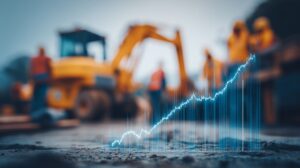In January, during his State of the Union Speech, controversial US President Donald Trump outlined his infrastructure vision. He called for Congress to advance plans to spend $US1.7 trillion over the next 10 years rebuilding the nation’s “crumbling infrastructure”.
The sheer size of the potential spend has caught the eyes and ears of Australia’s super funds seeking global infrastructure opportunities. “It would be great for all the noise Trump’s making there to create more opportunities,” says Nik Kemp, head of infrastructure at industry fund giant, AustralianSuper. “But I think the proof will be in the pudding and there’s a little way to go.”
But while Trump’s triumphalist infrastructure talk is seen as a positive in the long run, super funds are struggling to find infrastructure opportunities right now. Fierce competition for assets has pushed valuations to historically high levels and rates and yields are rising.
Super funds are being forced to adapt, by becoming more innovative both home and abroad. And they’re being forced to be patient and build the resources and firepower needed to swoop on opportunities around the world in the event of a downturn and falling valuations.
Global ambitions
Australia’s superannuation funds, particularly industry funds, have been increasing exposure to global unlisted infrastructure in recent years, including direct investment in assets, but despite that activity most of their investment remains at home where they have a competitive advantage.
According to APRA, at 30 June 2017, industry funds allocated 9 per cent of portfolios to infrastructure including 2 per cent to listed, 5 per cent to Australian unlisted, but just 2 per cent to international unlisted. Retail funds have been slower to push into infrastructure, allocating just 2 per cent of portfolios to infrastructure, with half that in listed; and 0 per cent to international unlisted.
But most funds are eyeing more offshore deals. AustralianSuper still has around two thirds of its unlisted infrastructure in the domestic market, but “if we double funds under management over the next five to 10 years, and all our infrastructure investment is done offshore, that wouldn’t be an issue,” Kemp says.
Kemp says the fund’s interest in global infrastructure is driven by access to a larger opportunity set. “There are considerably more opportunities to invest in globally, and hence the potential for higher risk adjusted returns,” he says. AustralianSuper is hunting for opportunities in North America and Europe, and is primarily interested in core infrastructure areas, including transport projects (roads, ports, airports), regulated utilities (power networks, water) and contracted assets.
Damian Graham, First State Super’s chief investment officer, says while his fund is most comfortable in Australian infrastructure, which has a heavy linkage to Australian inflation, “broadening our universe and getting opportunities offshore is something we’re very interested in. We’re looking at how we can avail ourselves of some of those opportunities in a fairly targeted fashion.”
Super funds’ global ambitions are being fuelled by the emergence of significant opportunities. PwC estimates the world needs to invest some $US78 trillion in infrastructure over the next two decades.
QIC’s head of global infrastructure, Ross Israel, says infrastructure is set to benefit from a number of macro tailwinds. Significant renewal is needed across transportation, energy and utilities, and mega trends like climate change, energy disruption and 5G telecommunications will drive investment. Government balance sheets are also still constrained, and they will be forced to turn to PPPs to fund both renewal and new growth infrastructure.
“Those things are macro factors in the background that help have a positive effect on the infrastructure pipeline,” he says.
Top of the cycle
The problem is that Australia’s super funds are not the only pension funds to be hungry for infrastructure deals. Infrastructure is becoming increasingly vital to investment plans because of its stable cash flows, low volatility and inherent inflation protection. According to researcher Prequin, some 56 pension funds have invested directly in infrastructure opportunities in the past 10 years, with a total of 275 direct investment deals. Pension funds invested $US48 billion in 2016 alone.
But that demand from big pension funds has helped to significantly push up values in recent years. “There is no doubt we’re at the high end of the historical cycle because of the chase for yield and cash flows in infrastructure assets,” QIC’s Israel says.
Funds are now struggling to find attractive deals. “We’re active, but it’s been a tough market,” Israel says, adding QIC tried to buy a Finnish regulated utility with significant potential late last year but was pipped in the transaction.
Rising interest rates and yields are unlikely to throw up opportunities, though, through big drops in valuations. While listed infrastructure, particularly, has suffered significant falls, which is creating opportunities in that sector (see breakout), unlisted infrastructure is less vulnerable to interest rate rises.
Israel says that many large institutional owners of infrastructure have accounted for the abnormally low interest rate environment and included a buffer in the risk-free rates used to value infrastructure. So unlisted infrastructure valuations won’t fall as much when interest rates rise.
Kemp agrees the impact of rising rates on infrastructure should be muted. “Within our portfolio, rates would have to increase quite substantially for me to be too worried,” he says.
Some funds are now taking advantage of the high prices and demand to sell. First State Super has sold legacy positions in several US utilities, including the biggest utility in Washington State, Puget, and Pittsburg-based power company, Duquesne, in which it had small (2.5 per cent to 3 per cent) positions. “We thought it was a good risk/return trade off to sell out of those positions to capitalise on very fruitful prices being paid for quality assets,” says head of income and real assets at First State Super, Damien Webb.
Getting creative
But despite that sales activity, most big super funds want more infrastructure deals. First State Super’s recent sales cut its infrastructure allocation to just 2.5 per cent of its flagship growth option. It wants that to rise to 7 per cent over the next three years.
First State Super’s Graham says the fund wants to up its infrastructure exposure as part of a broader push to access ‘illiquidity premia’ and income streams of property and infrastructure. Infrastructure also provides inflation protection, he adds.
In the wake of high valuations and strong demand for assets, one response has been for funds to ramp up their efforts scouring the world for deals. “You have just got to keep turning stones,” Israel says.
But most funds are also being forced to get more creative, including leveraging opportunities in existing assets and adding value through active management. Israel says QIC wants assets that require an active business plan “where there’s the ability to reimagine the business with a slightly different operating model”. QIC has also been seeking strategic partners to de-risk assets at acquisition. “We’re trying to create a differentiation in how we would view the business after acquisitions,” Israel says.
Some funds are also investing in infrastructure-like revenue streams in non-core assets. First State Super’s Graham says his fund is a seller of brownfields or existing assets and focusing on “wha
t we think are defendable infrastructure-like revenue streams”. That could mean buying an asset and executing a business model. But the fund is also open to “building an asset to get it ‘core’ over a period of time so we can see that de-risking and re-rating of income stream over”. (As part of this strategy State Super took a 30 per stake in a 35-year lease of NSW’s land registry title, which it secured for $2.6 billion as part of a consortium with Hastings Funds Management).
State Super is also exploring opportunities in emerging markets, with its infrastructure investment strategy allowing up to 20 per cent to be allocated to non-OECD or emerging markets. The fund has already had success with Equis, a fund spun out of Macquarie which developed a renewable power platform across Asia.
Patience required
But with high valuations and strong competition, executing on their global plans is above all requiring planning and patience. Most funds continue to monitor Trump’s plans, which could be another positive, though few are holding their breath. AustralianSuper’s Kemp notes that the disconnect between federal, state and municipal government in the US is “very political” and has made infrastructure deals hard in the US in recent years.
First State Super’s Webb says the fund could reach its 7 per cent allocation to infrastructure immediately. “But we are taking what we think is a prudent approach to this,” he says.
Kemp says his fund is looking but also being cautious. “We’re looking to position ourselves if there is a downturn coming so we can pounce on any opportunities that might come.”
Part of that preparation is building offshore capabilities. AustralianSuper now has an office in London, with its people there monitoring opportunities throughout Europe. “It’s about having the right relationships with the right people at the right time,” Kemp says. “To do that you need to have boots on the ground.”
Kemp says that after strong rises, valuations should at least begin stabilising. “I don’t think we will continue to see prices rise as a result of discount rate compression, which we have seen over the last four or five years,” he says. But the big chances will emerge when prices fall. “If there is a broader global downturn over the next few years, I hope we will see more attractive opportunities to invest.”
Listed infrastructure
Listed infrastructure has been particularly vulnerable to rises in official interest rates and bond yields, with the S&P Global Infrastructure Index falling 4.74 per cent in the past year as investors offloaded ‘bond proxies’. All three major global listed infrastructure sectors—utilities, industrial and energy—have been caught up in the sell-off.
“Right now it might not be the place to be,” says Alexander Cousley, an investment strategy analyst at Russell Investment. “No one wants to be around these assets when you’re in a rising interest rate environment.”
Some funds are actively avoiding listed infrastructure. “We don’t allocate to listed infrastructure at present,” says Michael Blayney, head of multi-asset at BT Investment Management. “Listed infrastructure has a high beta to equities (so it isn’t very diversifying in a portfolio sense) and is vulnerable to rising interest rates.”
The asset class’s valuation, including on an EV/EBITDA basis, has been trading significantly above long-term averages (see chart), but Cousley says that while it remains expensive, listed infrastructure is becoming more attractive.
Cousley says Russell believes rates will rise further, but the US 10-year bond yield is unlikely to go significantly above 3 per cent in the next 12 to 18 months. “Most of the pain that’s been felt in global listed infrastructure may have come through already, and the upside in rates is probably capped in our view. We are starting to warm towards it.”
Cousley also notes that global listed infrastructure is yielding 4.5 per cent. “That’s a fairly attractive dividend yield, particularly relative to equities,” he says.
He adds that if we start to see a flatter yield curve—with the short end rising more quickly than the longer-end—“that’s actually not that bad for global listed infrastructure’. Cousley says utilities (which make up 40 per cent of the GLI basket) tend to do well in flattening yield environments, as flatter yield curves signal lower inflation and slower growth, which sees a move into defensive stocks.




































